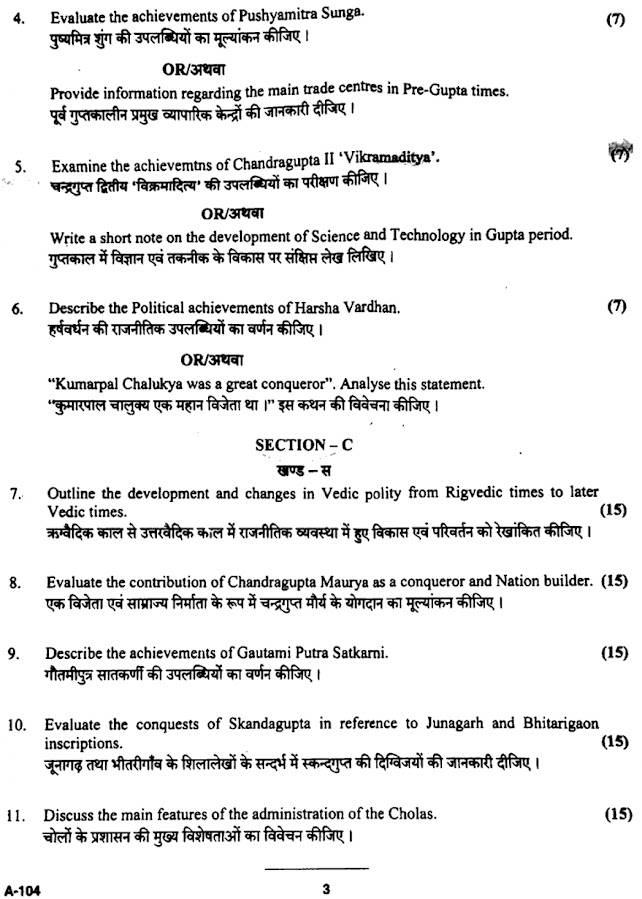Solved Old Paper B.A. - I (History - 2020) Paper - I
1. (i). Name four Vedas. चार वेदों के नाम लिखिए।
> The four Vedas are the Rigveda, the Yajurveda, the Samaveda, and the Atharvaveda.
(चार वेद ऋग्वेद, यजुर्वेद, सामवेद और अथर्ववेद हैं।)
(ii). Name any four 'Mahajanapadas'. किन्हीं चार महाजनपदों के नाम लिखिए।
> Kasi, Kosala, Anga and Magadha.
(काशी, कोशल, अंग और मगध।)
(iii). Who was Ajatshatru? अजातशत्रु कौन था?
> Ajatashatru, also known as Kunika, was the son of Bimbisara.
(अजातशत्रु, जिसे कुनिका के नाम से भी जाना जाता है, बिम्बिसार का पुत्र था।)
> The ancient inscription in the Government Museum, Mathura refers to him as Vaidehi putra Ajatashatru Kunika "Ajatashatru Kunika, son of Vaidehi".
(सरकारी संग्रहालय, मथुरा में प्राचीन शिलालेख उन्हें वैदेही पुत्र अजातशत्रु कुनिका "अजातशत्रु कुनिका, वैदेही का पुत्र" के रूप में संदर्भित करता है।)
> The story of Ajatashatru is found in the Tripitaka of Buddhism and the Jain Agamas.
(अजातशत्रु की कहानी बौद्ध धर्म के त्रिपिटक और जैन आगमों में मिलती है।)
(iv). Discuss any two causes of the downfall of the Mauryan Empire. मौर्य साम्राज्य के पतन के किन्हीं दो कारणों की विवेचना कीजिये।
> The decline of the Maurya Dynasty was rather rapid after the death of Ashoka.
(अशोक की मृत्यु के बाद मौर्य वंश का पतन काफी तेजी से हुआ।)
> One obvious reason for it was the succession of weak kings.
(इसका एक स्पष्ट कारण कमजोर राजाओं का उत्तराधिकार था।)
> Another immediate cause was the partition of the Empire into two.
(एक अन्य तात्कालिक कारण साम्राज्य का दो भागों में विभाजन था।)
(v). Write in brief the achievements of the Rudradaman I. रुद्रदमन प्रथम की उपलब्धियों को संक्षेप में लिखिए।
> Rudradaman I (130–150AD) was a Saka ruler from the Western Kshatrapas dynasty.
(रुद्रदामन I (130-150AD) पश्चिमी क्षत्रप वंश के एक शक शासक थे।)
> He was the king of Castana's grandson. Rudradaman I was a key figure in the Satavahana Empire's demise.
(वह कास्टाना के पोते का राजा था। रुद्रदामन प्रथम सातवाहन साम्राज्य के पतन में एक प्रमुख व्यक्ति था।)
> After becoming king, Rudradman I acquired the title of Maha-kshatrapa ("Great Satrap") and consolidated his realm.
(राजा बनने के बाद, रुद्रदामन प्रथम ने महा-क्षत्रप ("महान क्षत्रप") की उपाधि प्राप्त की और अपने दायरे को समेकित किया।)
> He is regarded as the most powerful of the Saka rulers.
(उन्हें शक शासकों में सबसे शक्तिशाली माना जाता है।)
(vi). Which dynasty did Kanishka I belong to? Describe briefly. कनिष्क प्रथम किस वंश से संबन्धित था? संक्षिप्त विवेचना कीजिये।
> Kaniska, Chinese Chia-ni-se-chia, (flourished 1st century ce), greatest king of the Kushan dynasty that ruled over the northern part of the Indian subcontinent, Afghanistan, and possibly areas of Central Asia north of the Kashmir region.
(कनिष्क, चीनी चिया-नी-से-चिया, (प्रथम शताब्दी ईस्वी में फला-फूला), कुषाण वंश का सबसे बड़ा राजा, जिसने भारतीय उपमहाद्वीप के उत्तरी भाग, अफगानिस्तान और संभवतः मध्य एशिया के क्षेत्रों के उत्तर में शासन किया। कश्मीर क्षेत्र।)
(vii). Discus the policy towards 'Dakshinapath' kings adopted by Samudra Gupta. समुद्रगुप्त द्वारा अपनाई गई 'दक्षिणापथ' राजाओं के प्रति नीति की चर्चा कीजिए।
> They were uprooted, and their kingdoms were made a part of Samudragupta's empire.
(उन्हें उखाड़ फेंका गया और उनके राज्यों को समुद्रगुप्त के साम्राज्य का हिस्सा बना दिया गया।)
> They surrendered to Samudragupta after being defeated and were allowed to rule again.
(पराजित होने के बाद उन्होंने समुद्रगुप्त के सामने आत्मसमर्पण कर दिया और उन्हें फिर से शासन करने की अनुमति दी गई।)
> They brought tribute, followed his orders, and attended his court.
(वे श्रद्धांजलि लेकर आए, उनके आदेशों का पालन किया और उनके दरबार में उपस्थित हुए।)
(viii). Who was Varahmihir? वराहमिहिर कौन था?
> Varahamihira was an Indian mathematician and astronomer of the 5th-6th century AD.
(वराहमिहिर ईसा की पाँचवीं-छठी शताब्दी के भारतीय गणितज्ञ एवं खगोलज्ञ थे।)
> It was Varahamihira who first told in his Panchasiddhantika that the value of ayanamsa is equal to 50.32 seconds.
(वाराहमिहिर ने ही अपने पंचसिद्धान्तिका में सबसे पहले बताया कि अयनांश का मान 50.32 सेकेण्ड के बराबर है।)
> He was one of the Navaratnas of Chandragupta Vikramaditya.
(यह चंद्रगुप्त विक्रमादित्य के नवरत्नों में से एक थे।)
> The Gurukul of mathematical science developed by him in Ujjain remained unique for seven hundred years.
(उज्जैन में उनके द्वारा विकसित गणितीय विज्ञान का गुरुकुल सात सौ वर्षों तक अद्वितीय रहा।)
(ix). Discuss any two features of Chola administration. चोल प्रशासन की किन्हीं दो विशेषताओं का वर्णन कीजिये।
> The Cholas believed in local self-government.
(चोल स्थानीय स्वशासन में विश्वास करते थे।)
> In many of the villages, the administration was carried out not by the government officials but by the villagers themselves.
(कई गांवों में प्रशासन सरकारी अधिकारियों द्वारा नहीं बल्कि स्वयं ग्रामीणों द्वारा किया जाता था।)
> These villages had three types of assemblies, namely the ur, the sabha and the nagaram.
(इन गाँवों में तीन प्रकार की सभाएँ होती थीं, उर, सभा और नगरम।)
(x). Write short notes on Bhoja Parmar. भोज परमार पर टिप्पणी लिखिए।
> Bhoja, also known as Raja Bhoj Parmar, was an Indian king from the Paramara dynasty who ruled from approximately 1010 until 1055 CE.
(भोज, जिन्हें राजा भोज परमार के नाम से भी जाना जाता है, परमार वंश के एक भारतीय राजा थे जिन्होंने लगभग 1010 से 1055 सीई तक शासन किया था।)
> His capital, Dhara-nagara (modern-day Dhar), was situated in the Malwa area of central India, which served as the hub of his kingdom.
(उनकी राजधानी, धारा-नगर (आज का धार), मध्य भारत के मालवा क्षेत्र में स्थित थी, जो उनके राज्य के केंद्र के रूप में कार्य करती थी।)


